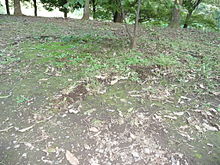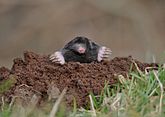27:
39:
183:
174:
165:
156:
116:
Molehills are often the only sign to indicate the presence of the animal and recording their presence may be the most reliable way to determine the number of moles in an area. Commonly they occur in lines along the route of the burrow, but in some cases they may not be directly above the burrow
143:
can be planted. The fresh molehills can also be removed carefully as soon as they appear. This leaves the animals and their galleries undamaged and thus reduces the need for the moles to make further molehills when they clear earth out of the tunnels.
108:
Molehills are waste material which come from digging or repairing burrows, and so are usually found where the animal is establishing new burrows, or where existing ones are damaged (for example by the weight of grazing
113:). Where moles burrow beneath the roots of trees or shrubs, the roots support the tunnel, and molehills are less common, and so even a dense population of the animals may be inconspicuous in these places.
120:
The disturbance of the soil brings an important benefit by aerating and tilling it, adding to its fertility. Molehills are therefore sometimes used as a source of good soil for use in
93:. The word is first recorded in the first half of the 15th century. Formerly the hill was known as a 'wantitump', a word still in dialect use for centuries afterwards.
128:
for fine potting soil. However, they may cause damage to gardens and functional areas of grass such as pasture land, and they represent a minor safety hazard. King
117:
itself but at the ends of short side-tunnels. The mole runs vary in depth from surface runs only a few inches deep, to main runs, some 12 to 18 inches deep.
317:
97:
264:
363:
341:
230:
129:
358:
20:
329:
136:
135:
In locations where mole-hills are not desired, the moles may be killed, or deterrent plants like
47:
368:
140:
132:
is recorded as dying from complications after he was thrown when his horse stumbled on one.
352:
82:
43:
26:
291:
125:
51:
243:
268:
203:
121:
110:
38:
100:" is commonly used metaphorically to mean "to exaggerate a minor problem".
86:
31:
78:
75:
37:
25:
182:
173:
164:
155:
90:
71:
227:
124:
and are particularly valued by some practitioners of
312:Helen Yemm, "Using molehills to your advantage":
267:. Pest-management.co.uk. 2009. Archived from
8:
328:C N Trueman, "William III", cited on the
16:Mound of soil raised by burrowing mammals
195:
151:
7:
244:"Searching for nature's tunnellers"
98:making a mountain out of a molehill
85:, but also similar animals such as
30:Several lines of molehills in the
14:
292:"Managing Wildlife Damage: Moles"
294:. Virginia Cooperative Extension
181:
172:
163:
154:
242:Mukherjee, Sarah (2008-01-25).
70:) is a conical mound of loose
19:For the hill in Virginia, see
1:
204:"the definition of molehill"
385:
18:
148:Gallery: a mole emerging
130:William III of England
55:
35:
330:History Learning site
46:pass of molehills at
41:
29:
21:Mole Hill (Virginia)
340:Mole Advice Sheet,
104:Evidence of burrows
364:Mammals in culture
229:(1875), Volume 7,
56:
48:Kasori Shell Mound
36:
342:Mole Advice Sheet
271:on April 26, 2012
141:castor bean plant
376:
344:
338:
332:
326:
320:
310:
304:
303:
301:
299:
290:Parkhurst, Jim.
287:
281:
280:
278:
276:
261:
255:
254:
252:
251:
239:
233:
224:
218:
217:
215:
214:
200:
185:
176:
167:
158:
74:raised by small
384:
383:
379:
378:
377:
375:
374:
373:
349:
348:
347:
339:
335:
327:
323:
311:
307:
297:
295:
289:
288:
284:
274:
272:
263:
262:
258:
249:
247:
241:
240:
236:
225:
221:
212:
210:
202:
201:
197:
193:
186:
177:
168:
159:
150:
139:or the related
106:
24:
17:
12:
11:
5:
382:
380:
372:
371:
366:
361:
351:
350:
346:
345:
333:
321:
318:15 March, 2003
305:
282:
265:"Mole Control"
256:
234:
219:
208:Dictionary.com
194:
192:
189:
188:
187:
180:
178:
171:
169:
162:
160:
153:
149:
146:
105:
102:
15:
13:
10:
9:
6:
4:
3:
2:
381:
370:
367:
365:
362:
360:
357:
356:
354:
343:
337:
334:
331:
325:
322:
319:
315:
314:The Telegraph
309:
306:
293:
286:
283:
270:
266:
260:
257:
245:
238:
235:
232:
228:
223:
220:
209:
205:
199:
196:
190:
184:
179:
175:
170:
166:
161:
157:
152:
147:
145:
142:
138:
133:
131:
127:
123:
118:
114:
112:
103:
101:
99:
94:
92:
88:
84:
80:
77:
73:
69:
65:
61:
53:
49:
45:
40:
33:
28:
22:
359:Garden pests
336:
324:
313:
308:
296:. Retrieved
285:
273:. Retrieved
269:the original
259:
248:. Retrieved
237:
226:
222:
211:. Retrieved
207:
198:
137:caper spurge
134:
126:permaculture
119:
115:
107:
96:The phrase "
95:
81:, including
67:
63:
59:
57:
353:Categories
298:August 13,
250:2015-04-26
213:2018-03-21
191:References
68:mole mound
122:gardening
111:livestock
87:mole-rats
76:burrowing
64:mole-hill
42:Trail of
369:Talpidae
275:26 April
60:molehill
79:mammals
32:pasture
89:, and
246:. BBC
231:p.564
91:voles
83:moles
52:Chiba
300:2008
277:2015
72:soil
62:(or
54:city
44:mole
355::
316:,
206:.
66:,
58:A
50:,
302:.
279:.
253:.
216:.
34:.
23:.
Text is available under the Creative Commons Attribution-ShareAlike License. Additional terms may apply.





